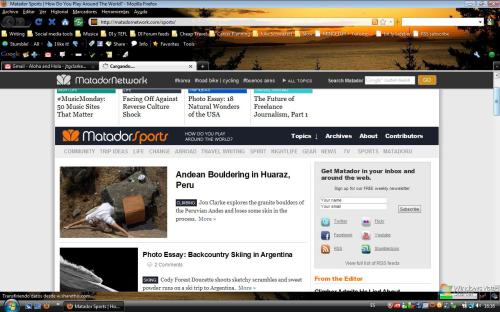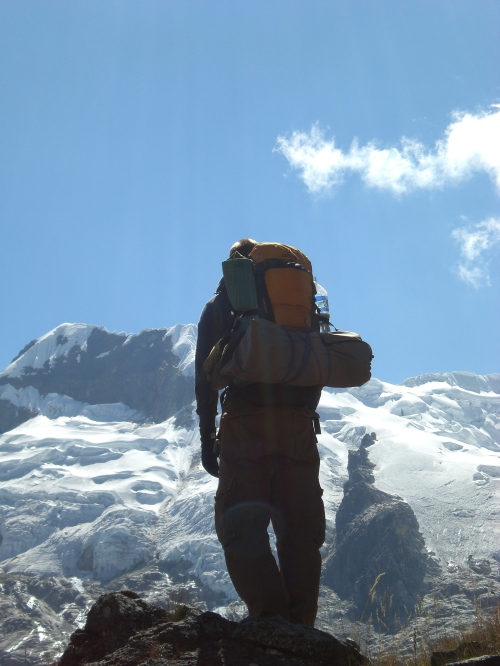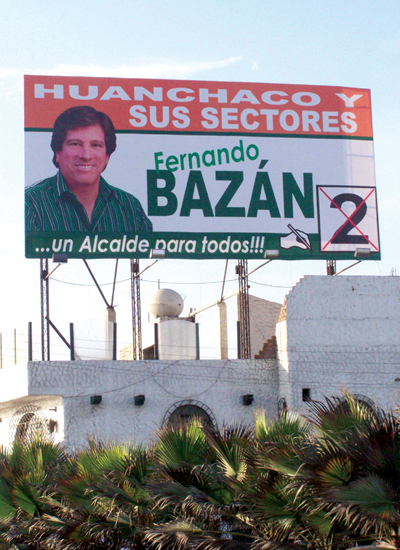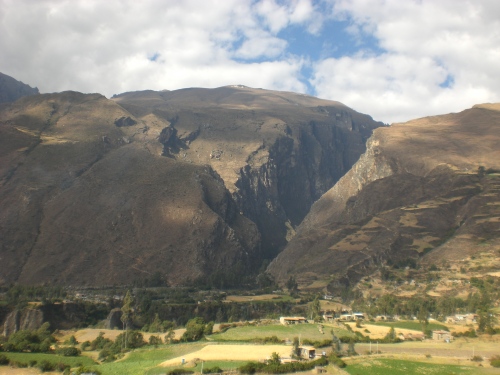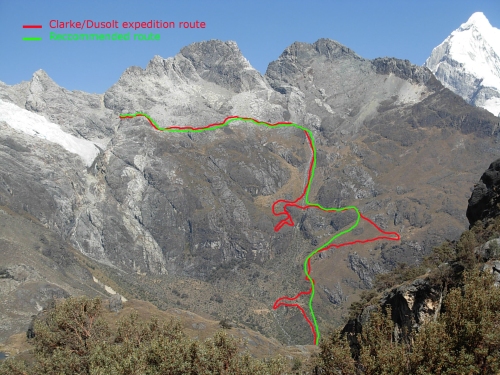
I exit the bathroom briskly to be confronted by a selection of expressions. Two of them belong to police officers, the other pair to Peruvian truck drivers. Luckily for me, the police officers look delighted. The truck drivers, not so much.
“We have found you a ride!” exclaims one of the policemen, thus signalling the end of my four-hour wait at the police control point on the scutty outskirts of Huaraz.
I’m attempting a return hitch solo, Miri having left town some days previous to meet her brother in Lima. My newfound lust for adventure ever-increasing, I’m attempting a more remote route back to Trujillo over the mountains to Casma. Up until now it has been an abject failure, but things are looking up.
Giving grovelling thanks to the friendly fuzz, I follow the sour faced drivers out to their vehicle. It’s a wooden sided camion, with a door set into the side that one of the drivers pops open and impatiently gestures through. Tossing my bags inside I plant my foot on the tire for a boost and step up strongly through the tiny doorway, striking the top of my head on the frame with painful mis-judgement.
My vision swims and I hear a sharp intake of breath from somewhere inside the belly of the enclosed truck bed. “Ooh, gringo, cuidado,” someone says. Normal vision returns, and I realise there are already various occupants in my plank-lined cell. The truck sets off with a shuddering grind of gears, and I slump on a sack of something, groping for a brace against the random bumps that test my balance.
My truck-mates begin tying blankets to various parts of the sides of the enclosure, creating makeshift sun-shades to protect against the beating sun. They arrange themselves around the few full sacks dotted around the otherwise empty truck. I realize I’m in for a toasting without sun cream, and pull out a tube. “Ooh gingo, prestamelo”, whines one of the señoras; lend me some. That proves to be the ice-breaker and within ten minutes I’ve set up my tent inside the truck-bed as a sunshade for some of the occupants and Sun Cream Lady has led me to the shelf above the drivers cabin at the front of the truck where I ride up high feeling like the king of the world as we climb out of the valley and over the Cordillera Negra. It turns out all the occupants are in cahoots with the driver, everyone heading to Chimbote to sell the contents of the sacks and bring back a full truck of wood.
It isn’t long before the driver pulls to a halt to reprimand me for sitting above the cab. “You could fall off the front,” he grumbles. I retire sheepishly to the interior of the truck-bed once more, my romantic bubble well and truly burst.
The truck rolls to a stop once more. “We’re getting out for lunch,” explains one of my fellow in-mates. “Afterwards you wait here while we fetch wood. We can’t continue because the road is closed for work until five in the afternoon.” I’m buggered if I’m waiting around for a few hours. “I’ll come with you,” I cheerfully suggest, “I want to be useful.” “Suit yourself,” he replies. Thus I board the truck through the back door once more, this time with significantly more caution than the first attempt. Leaving the women-folk behind, we rumble off into the hills.
A steady stream of men join us and after a meandering 45 minutes we reach a large pile of wood. Everyone exits the truck to hurl helpful abuse at the driver, who attempts a multiple-point turn on a matchstick-thin path which crowns a cliff. Eventually the truck and driver are facing back from whence we came and a chain gang is set up, hurling logs into the back at speed. “Eeyy gringo, do they work this hard in Germany?” grins one of the log-chuckers. “No, in my country everyone is fat and sits in-front of a computer all day,” I reply, deciding that it is easier to continue harbouring the illusion of my native origins.
Job done and full of splinters, we sit astride the vast pile of logs and sluggishly wobble back along the narrow track, certain death a couple of crumbling feet away. Conversation swings between Quechua and Spanish so eventually I lose interest in keeping track of the dialogue. At some point a four-wheel drive pickup pulls across our path ahead of the bus and the driver descends to converse with the occupants. “What’s going on?” I ask my log-chum. “They are angry because we don’t have a permit to remove wood from this zone,” he tells me, “And there will be a fine.” Money changes hands and with the delay in crooked negotiations we arrive back into town as darkness is falling. There’s no way I’m going to make it to Trujillo today. “No problem, sleep on the floor of the market with us,” the driver suggests, shattering all my preconceptions of him being a bad-tempered bastard. My internal adventure rating slips off the scale with a click.
“Where the fuck have you been?” the women chirp as they climb back into the truck laden with gigantic bundles that I try in vain to assist them with. “We had to negotiate a bribe,” I explain. They tut and roll their eyes. Our vehicle rolls off into the setting sun along the winding mountain dust.
I’m sitting on a giant pile of wood in the back of a bumping truck as the stars pop out of the twilight that steadily consumes the burning sky of sunset. In the gathering dusk, the women open their bundles, chattering to each other in the sing-song dialect of Quechua. The thick fragrance of wild herbs fills the air and my soul swells to the point of exploding with the sheer ridiculous joy of my immediate present, right now.
They sort through the herbs and bunch them by moonlight, passing me bread from a large bag and following it up with a blanket. With my head crooked at an angle that I know will make me suffer, I drift off to sleep. Occasionally someone clambers on to the truck and steps on my face with a surprised, “Eeyy, gringo,” before I return to slumber. Headlights fade in and out of my consciousness. Road works, groups of floodlights cutting through the darkness, blotting out the stars, workmen, voices.
Voices, packages passed up, lowered, groups waiting patiently in the darkness by the side of the road, whole communities lined up. Waiting for the truck.
2am. As if cued for an exposition scene in a movie, I drift into a state of awareness as we pass under the sign for Casma.
The engine cuts. “Gringo! We get down now.” I stumble from the truck with my neck jacked up hard to the left and my bags dangling from my arms. They throw a blanket down on the floor under a canopy in the dark. It smells worse than the one I slept under in the truck. Sandwiched between the stinking warmth with my bag for a pillow I sink again as shadows move in the growing distance.
…
I awake with a start to the sight of an old man staring down over me. “Buenos dias,” I offer groggily and he shakes his head, shuffling off. Bloody gringos. 6.30am. The movement and noise trickles down into my senses and I realize that I’m lying in the middle of a busy market. I quickly sit up. My bags lie a couple of feet from where I left them, untouched; I clock at this point that during my whole experience at the utter mercy of my travelling companions, I never once felt threatened or in danger. I rise to my feet and stare stupidly at the new incarnation of my travellers; slick business-people selling the wares. I blunder over to one of the guys. “When did you get up?” I ask in the absence of anything else to say. “I haven’t been to sleep,” he cheerfully replies before attending to a customer that seems to be interested in his beans.
My bloodshot eyes take in the scene. I have absolutely no idea where I am, and I’m the only white chap in the entire market. Shouldering my bags, as a paltry expression of thanks I offer a handshake to the guys and a peck on the cheeks of the girls that leaves the surrounding gentry clucking. I’ve not made it all the way to Trujillo, but I know when I’ve had my fill of adventure. Wandering via a filthy cup of instant coffee to the exit, I squeeze into the first taxi that I can flag down and submit to the luxury of a direct bus to Trujillo from the central Chimbote terminal.


